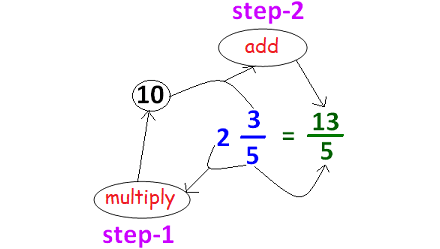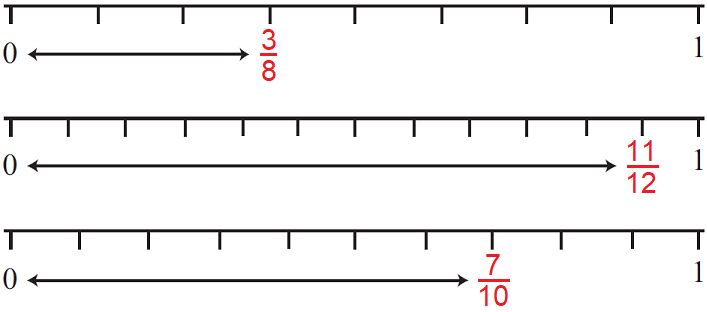FRACTIONS WORKSHEET
Question 1 :
Classify the values given below as proper fraction, improper fraction and mixed fraction.
⅔, ⁵⁄₂, 5½, ⅞, 0.2, 1.3
Question 2 :
Write down five fractions equivalent to ⅔.
Question 3 :
Evaluate :
²⁄₇ + ³⁄₇
Question 4 :
Evaluate :
⁷⁄₉ - ⁵⁄₉
Question 5 :
Evaluate :
⅛ + ⅝ - ⅜
Question 6 :
Evaluate :
¼ + ⅙
Question 7 :
Evaluate :
⅚ x ⁸⁄₁₁
Question 8 :
Evaluate :
⅔ x ⁵⁄₇
Question 9 :
Evaluate :
⅜ ÷ ¹⁵⁄₁₆
Question 10 :
Write down 1¾ in five different ways, including at least one improper fraction.
Question 11 :
Share a chocolate bar with 32 pieces, equally between four friends. Write down the fraction they each receive in five different ways.
Question 12 :
Write 7 as a fraction in five different ways.
Question 13 :
How many thirds make 5 whole ones?
Question 14 :
Convert the mixed fraction 2⅗ to an improper fraction.
Question 15 :
Convert the improper fraction ¹⁷⁄₅ to a mixed fraction.
Question 16 :
Represent the following fractions on a number line.
⅗, ¹¹⁄₁₂ and ⁷⁄₁₀
Question 17 :
In a fraction, the numerator is 2 less than the denominator. Increasing both numerator and denominator of the fraction by 3 results ⁵⁄₇. Find the fraction.
Question 18 :
James gave one-fourth of a pizza to his brother and gave one-fifth of the remaining to his friend and kept the rest for himself. What fraction of the pizza did James keep for himself?

Answers
1. Answer :
⅔, ⁵⁄₂, 5½, ⅞, 0.2, 1.3
⅔ -----> Proper fraction
⁵⁄₂ -----> Improper fraction
5½ -----> Mixed fraction
⅞ -----> Proper fraction
0.3 = ³⁄₁₀ -----> Proper fraction
1.3 = ¹³⁄₁₀ -----> Improper fraction
2. Answer :
Multiply the numerator and denominator of the fraction ⅔ by 2, 3, 4, 5 and 6 to get five fractions which are equivalent to 2/3.
3. Answer :
= ²⁄₇ + ³⁄₇
Since the above two fractions have the same denominator, the denominator can be taken once and add the numerators.
= ⁽² ⁺ ³⁾⁄₇
= ⁵⁄₇
4. Answer :
= ⁷⁄₉ - ⁵⁄₉
Since the above two fractions have the same denominator, the denominator can be taken once and subtract numerators.
= ⁽⁷ ⁻ ⁵⁾⁄₉
= ²⁄₉
5. Answer :
= ⅛ + ⅝ - ⅜
Since the above fractions have the same denominator, the denominator can be taken once and combine the numeartors.
= ⁽¹ ⁺ ⁵ ⁻ ³⁾⁄₈
= ⅜
6. Answer :
= ¼ + ⅙
The above fractions do not have the same denominator.
Find the least common multiple of the denominators 4 and 6.
Least common multiple of the denominators (4, 6) is 12.
Make the denominators of both the fractions as 12 by multiplying the numerators and denominators by appropriate numbers
= ⁽¹ˣ³⁾⁄₍₄ₓ₃₎ + ⁽¹ˣ²⁾⁄₍₆ₓ₂₎
= ³⁄₁₂ + ²⁄₁₂
Now, the above two fractions have the same denominator. So, the denominator can be taken once and combine the numeartors.
= ³⁄₁₂ + ²⁄₁₂
= ⁽³ ⁺ ²⁾⁄₁₂
= ⁵⁄₁₂
7. Answer :
= ⅚ x ⁸⁄₁₁
The denominator of the first fraction 6 and the numerator of the second fraction 8 have the common divisor 2. So, divide 6 and 8 by 2. (Note : This kind of division can be done only with numerator and denomiator, not with numerator and numerator or denominator with denominator).
= ⁵⁄₃ x ⁴⁄₁₁
Multiply the numerators and denominators.
= ²⁰⁄₃₃
8. Answer :
= ⅔ x ⁸⁄₇
Here, there is no common divisor for any numerator and any denominator. So, multiply the numerators and denominators.
= ¹⁶⁄₂₁
9. Answer :
= ⅜ ÷ ¹⁵⁄₁₆
Change the division to multiplication and take reciprocal for the second fraction ¹⁵⁄₁₆.
= ⅜ x ¹⁶⁄₁₅
Simplify.
= ¹⁄₁ x ⅖
Multiply the numerators and denominators.
= ⅖
10. Answer :
Multiply the numerator and denominator of the fractional part of 1¾ by 2, 3, 4, and 5 to write down 1¾ in four different ways.
To get an improper fraction which is equivalent to 1¾, multiply the whole number 1 by the denominator 4 then add the numerator before writing it all over the denominator.
In this way, we can write down 1¾ in five different ways, including at one improper fraction as shown below.
11. Answer :
A chocolate bar is divided into 32 pieces and those 32 pieces are divided among four friends.
Number of pieces each friend gets :
= 32 ÷ 4
= 8
Each friend gets 4 out of 32 pieces.
= 8 ÷ 32
= ¼
Each friend gets ⅛ part of the chocolate bar.
We can multiply the numerator and denominator of the fraction ¼ by 2, 3, 4, 5 and 6 to write down the fraction they each receive in five different ways.
12. Answer :
We can write any integer as a fraction by taking the denominator as 1.
So, the first way to write 7 as a fraction is ⁷⁄₁.
Further, we can multiply the numerator and denominator of the fraction ⁷⁄₁ by 2, 3, 4 and 5 to write ⁷⁄₁ in four more different ways.
In this way, we can write 7 as a fraction in five different ways as shown below.
13. Answer :
One third = ⅓
We need 3 thirds to make 1 whole one.
1 whole one = 3 thirds
5 whole ones = 5(3 thirds)
= 15 thirds
15 thirds make 5 whole ones.
14. Answer :
We can convert the mixed fraction 2⅗ to an improper fraction as shown below.

2⅗ = 13/5
15. Answer :
We can convert the improper fraction 17/5 to a mixed fraction as shown below.

¹⁷⁄₅ = 3⅖
16. Answer :

17. Answer :
Let x be the denominator.
Given : The numerator of the fraction is 2 less than the denominator.
Then, the fraction is
= ⁽ˣ ⁻ ²⁾⁄ₓ ----(1)
Given : Increasing both numerator and denominator of the fraction by 3 results ⁵⁄₇.
⁽ˣ ⁻ ² ⁺ ³⁾⁄₍ₓ ₊ ₃₎ = ⅘
⁽ˣ ⁺ ¹⁾⁄₍ₓ ₊ ₃₎ = ⅘
5(x + 1) = 4(x + 3)
5x + 5 = 4x + 12
x + 5 = 12
x = 7
Substitute x = 7 in (1).
fraction = ⁽⁷ ⁻ ²⁾⁄₇
= ⁵⁄₇
18. Answer
Amount of pizza left after James gave ¼ of it to his brother :
= ¾
Amount of pizza james gave his friend :
= ⅕ of ¾
= ⅕ x ¾
= ³⁄₂₀
Fraction of pizza James kept for himself :
= 1 - ¼ - ³⁄₂₀
= ²⁰⁄₂₀ - ⁵⁄₂₀ - ³⁄₂₀
= ⁽²⁰ ⁻ ⁵ ⁻ ³⁾⁄₂₀
= ¹²⁄₂₀
= ⅗
Kindly mail your feedback to v4formath@gmail.com
We always appreciate your feedback.
©All rights reserved. onlinemath4all.com
Recent Articles
-
Ratio Worksheet
Apr 29, 24 07:59 PM
Ratio Worksheet -
Trigonometry Quotient Identities
Apr 29, 24 08:51 AM
Trigonometry Quotient Identities -
Trigonometry Reciprocal Identities
Apr 28, 24 10:10 AM
Trigonometry Reciprocal Identities